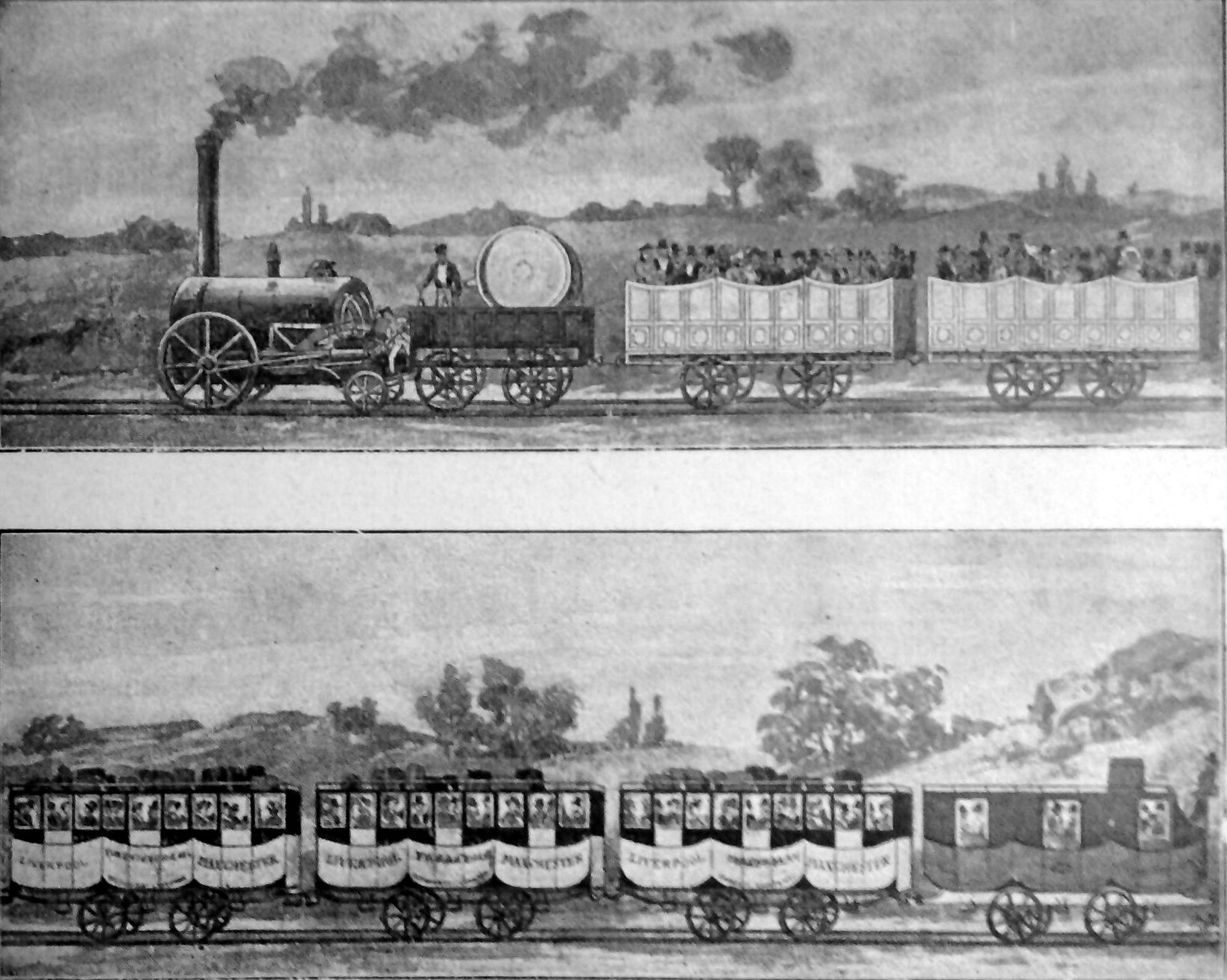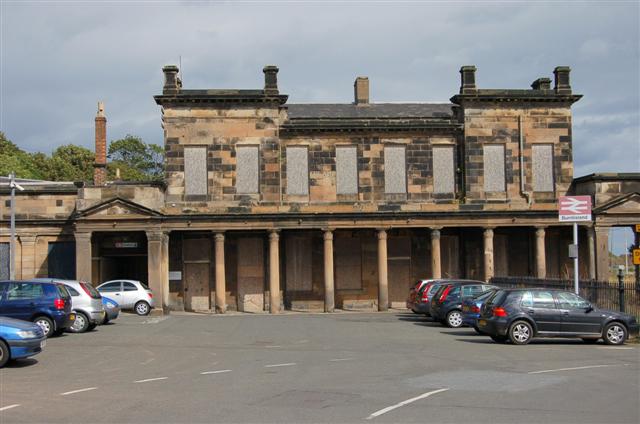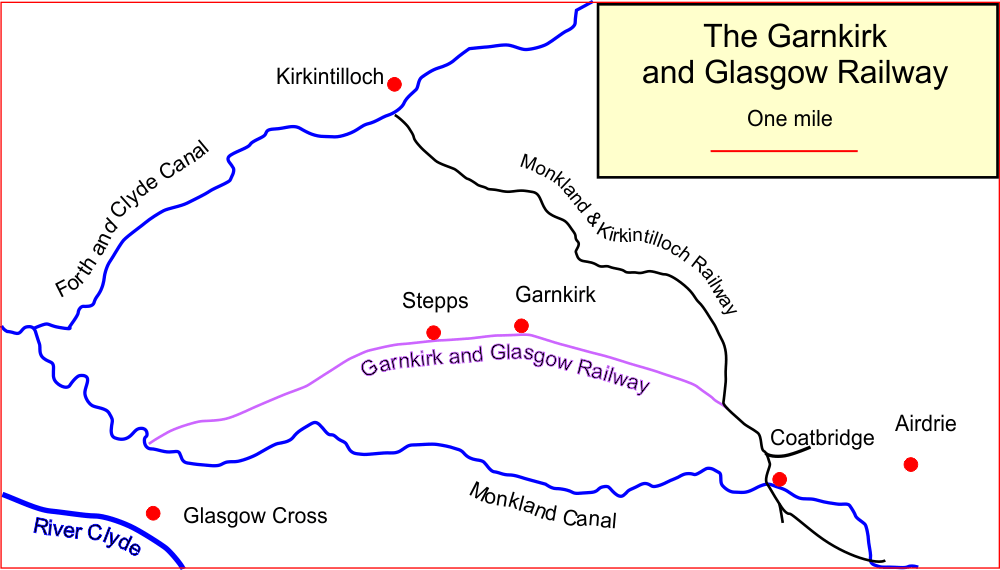|
Edinburgh And Glasgow Railway
The Edinburgh and Glasgow Railway was authorised by Act of Parliament on 4 July 1838. It was opened to passenger traffic on 21 February 1842, between its Glasgow Queen Street railway station (sometimes referred to at first as Dundas Street) and Haymarket railway station in Edinburgh. Construction cost £1,200,000 for 46 miles (74 km). The intermediate stations were at Corstorphine (later Saughton), Gogar, Ratho, Winchburgh, Linlithgow, Polmont, Falkirk, Castlecary, Croy, North Lanarkshire, Croy, Kirkintilloch (later Lenzie) and Bishopbriggs. There was a ticket platform at Cowlairs. The line was extended eastwards from Haymarket to North Bridge, Edinburgh, North Bridge in 1846, and a joint station for connection with the North British Railway was opened on what is now Edinburgh Waverley railway station in 1847. The quantity of passenger business on the line considerably exceeded estimates, reaching almost double the daily volume, and by 1850 company needed 58 locomotives ... [...More Info...] [...Related Items...] OR: [Wikipedia] [Google] [Baidu] |
Glasgow Queen Street Railway Station
Glasgow Queen Street ( gd, Sràid na Banrighinn) is a passenger railway terminus serving the city centre of Glasgow, Scotland. It is the smaller of the city's two mainline railway terminals (the larger being Glasgow Central station, Glasgow Central) and is the third busiest station in Scotland behind Central and Edinburgh Waverley railway station, Edinburgh Waverley. It connects Glasgow with Edinburgh, the capital of Scotland, via the Glasgow–Edinburgh via Falkirk line and the North Clyde Line. Other significant connections include the West Highland Line for services to and from the Scottish Highlands, the Highland Main Line and Glasgow–Dundee line. The station is split into two levels with high level trains predominantly serving the Edinburgh shuttle and further afield destinations, while the low level platforms serve trains covering the Central Belt of Scotland. The station is located between George Street to the south and Cathedral Street Bridge to the north and is at the ... [...More Info...] [...Related Items...] OR: [Wikipedia] [Google] [Baidu] |
North British Railway
The North British Railway was a British railway company, based in Edinburgh, Scotland. It was established in 1844, with the intention of linking with English railways at Berwick. The line opened in 1846, and from the outset the company followed a policy of expanding its geographical area, and competing with the Caledonian Railway in particular. In doing so it committed huge sums of money, and incurred shareholder disapproval that resulted in two chairmen leaving the company. Nonetheless the company successfully reached Carlisle, where it later made a partnership with the Midland Railway. It also linked from Edinburgh to Perth and Dundee, but for many years the journey involved a ferry crossing of the Forth and the Tay. Eventually the North British built the Tay Bridge, but the structure collapsed as a train was crossing in high wind. The company survived the setback and opened a second Tay Bridge, followed soon by the Forth Bridge, which together transformed the railway networ ... [...More Info...] [...Related Items...] OR: [Wikipedia] [Google] [Baidu] |
Forth And Clyde Canal
The Forth and Clyde Canal is a canal opened in 1790, crossing central Scotland; it provided a route for the seagoing vessels of the day between the Firth of Forth and the Firth of Clyde at the narrowest part of the Scottish Lowlands. This allowed navigation from Edinburgh on the east coast to the port of Glasgow on the west coast. The canal is long and it runs from the River Carron at Grangemouth to the River Clyde at Bowling, and had an important basin at Port Dundas in Glasgow. Successful in its day, it suffered as the seagoing vessels were built larger and could no longer pass through. The railway age further impaired the success of the canal, and in the 1930s decline had ended in dormancy. The final decision to close the canal in the early 1960s was made due to maintenance costs of bridges crossing the canal exceeding the revenues it brought in. However, subsidies to the rail network were also a cause for its decline and the closure ended the movement of the east-coast ... [...More Info...] [...Related Items...] OR: [Wikipedia] [Google] [Baidu] |
Liverpool And Manchester Railway
The Liverpool and Manchester Railway (L&MR) was the first inter-city railway in the world. It opened on 15 September 1830 between the Lancashire towns of Liverpool and Manchester in England. It was also the first railway to rely exclusively on locomotives driven by steam power, with no horse-drawn traffic permitted at any time; the first to be entirely double track throughout its length; the first to have a true signalling system; the first to be fully timetabled; and the first to carry mail. Trains were hauled by company steam locomotives between the two towns, though private wagons and carriages were allowed. Cable haulage of freight trains was down the steeply-graded Wapping Tunnel to Liverpool Docks from Edge Hill junction. The railway was primarily built to provide faster transport of raw materials, finished goods and passengers between the Port of Liverpool and the cotton mills and factories of Manchester and surrounding towns. Designed and built by George Stephen ... [...More Info...] [...Related Items...] OR: [Wikipedia] [Google] [Baidu] |
John Miller (engineer)
John Miller of Leithen FRSE MICE DL (26 July 1805 – 8 May 1883) was a Scottish civil engineer and Liberal Party politician. Together with Thomas Grainger, he formed the influential engineering firm Grainger and Miller, specialising in railway viaducts. Life Miller was born in Ayr on 26 July 1805, the son of Margaret Caldwell and James Miller, a wright and builder. He attended Ayr Academy and then studied law at the University of Edinburgh going on to be a legal apprentice with A Murdoch Esq, a lawyer in Ayr. His interests then turned from law to engineering. In 1825 he went into partnership with Thomas Grainger. The partnership was responsible for many of Scotland's railway projects. Miller took the lead role in surveying the Edinburgh and Glasgow Railway. He designed many viaducts, including the Lugar Viaduct, Almond Valley Viaduct, Cumnock and the Ballochmyle Viaduct, Mauchline. Miller designed and led the construction of the Almond Valley Viaduct to carry the Glasgow–Ed ... [...More Info...] [...Related Items...] OR: [Wikipedia] [Google] [Baidu] |
Thomas Grainger
Thomas Grainger FRSE (12 November 1794 – 25 July 1852) was a Scottish civil engineer and surveyor. He was joint partner with John Miller in the prominent engineering firm of Grainger & Miller. Life Grainger was born at Gogar Green near Ratho, outside Edinburgh to Helen Marshall and Hugh Grainger. Educated at the University of Edinburgh, at 16 he got a job with John Leslie, a land surveyor. He started his own practice in 1816, and in 1825 he formed a partnership with John Miller which lasted until 1847. Their firm operated from the ground floor of Grainger's house at 56 George Street, in the centre of Edinburgh's New Town. Between 1845 and 1849 his company worked on the digging of the Bramhope Tunnel and building the Arthington Viaduct as part of laying the Leeds to Stockton-on-Tees line. The first modern rail ferry, the ''Leviathan'', was designed in 1849 by Grainger for the Edinburgh, Perth and Dundee Railway to cross the Firth of Forth between Granton and Burntisland ... [...More Info...] [...Related Items...] OR: [Wikipedia] [Google] [Baidu] |
Edinburgh
Edinburgh ( ; gd, Dùn Èideann ) is the capital city of Scotland and one of its 32 Council areas of Scotland, council areas. Historically part of the county of Midlothian (interchangeably Edinburghshire before 1921), it is located in Lothian on the southern shore of the Firth of Forth. Edinburgh is Scotland's List of towns and cities in Scotland by population, second-most populous city, after Glasgow, and the List of cities in the United Kingdom, seventh-most populous city in the United Kingdom. Recognised as the capital of Scotland since at least the 15th century, Edinburgh is the seat of the Scottish Government, the Scottish Parliament and the Courts of Scotland, highest courts in Scotland. The city's Holyrood Palace, Palace of Holyroodhouse is the official residence of the Monarchy of the United Kingdom, British monarchy in Scotland. The city has long been a centre of education, particularly in the fields of medicine, Scots law, Scottish law, literature, philosophy, the sc ... [...More Info...] [...Related Items...] OR: [Wikipedia] [Google] [Baidu] |
Glasgow
Glasgow ( ; sco, Glesca or ; gd, Glaschu ) is the most populous city in Scotland and the fourth-most populous city in the United Kingdom, as well as being the 27th largest city by population in Europe. In 2020, it had an estimated population of 635,640. Straddling the border between historic Lanarkshire and Renfrewshire, the city now forms the Glasgow City Council area, one of the 32 council areas of Scotland, and is governed by Glasgow City Council. It is situated on the River Clyde in the country's West Central Lowlands. Glasgow has the largest economy in Scotland and the third-highest GDP per capita of any city in the UK. Glasgow's major cultural institutions – the Burrell Collection, Kelvingrove Art Gallery and Museum, the Royal Conservatoire of Scotland, the Royal Scottish National Orchestra, Scottish Ballet and Scottish Opera – enjoy international reputations. The city was the European Capital of Culture in 1990 and is notable for its architecture, cult ... [...More Info...] [...Related Items...] OR: [Wikipedia] [Google] [Baidu] |
Garnkirk And Glasgow Railway
The Garnkirk and Glasgow Railway was an early railway built primarily to carry coal to Glasgow and other markets from the Monkland coalfields, shortening the journey and bypassing the monopolistic charges of the Monkland Canal; passenger traffic also developed early in the line's existence. It opened officially on 27 September 1831 using horse traction, and had the track gauge of that had been adopted by the Monkland and Kirkintilloch Railway, with which it was to connect. It was dependent on the Monkland and Kirkintilloch Railway for access to the best areas of the coalfields, but eventually it by-passed this constraint by extending its line southwards through Coatbridge, enabling a direct link with another coal railway, the Wishaw and Coltness Railway. Widening its horizons it changed its name to the Glasgow, Garnkirk and Coatbridge Railway. The track gauge originally chosen was now a limitation and it altered its gauge to the standard of . When the Caledonian Railway advanc ... [...More Info...] [...Related Items...] OR: [Wikipedia] [Google] [Baidu] |
Monkland And Kirkintilloch Railway
The Monkland and Kirkintilloch Railway was an early mineral railway running from a colliery at Monklands to the Forth and Clyde Canal at Kirkintilloch, Scotland. It was the first railway to use a rail ferry, the first public railway in Scotland,Henry Grote Lewin, ''The British Railway System'', G Bell and Sons Ltd, London, 1914 and the first in Scotland to use locomotive power successfully, and it was a major influence in the successful development of the Lanarkshire iron industry. It opened in 1826. It was built to enable the cheaper transport of coal to market, breaking the monopoly of the Monkland Canal. It connected with the Forth and Clyde Canal at Kirkintilloch, giving onward access not only to Glasgow, but to Edinburgh as well. The development of good ironstone deposits in the Coatbridge area made the railway successful, and the ironstone pits depended at first on the railway. Horse traction was used at first, but steam locomotive operation was later introduced: the f ... [...More Info...] [...Related Items...] OR: [Wikipedia] [Google] [Baidu] |
Kilmarnock And Troon Railway
The Kilmarnock and Troon Railway was an early railway line in Ayrshire, Scotland. It was constructed to bring coal from pits around Kilmarnock to coastal shipping at Troon Harbour, and passengers were carried. It opened in 1812, and was the first railway in Scotland to obtain an authorising Act of Parliament; it would soon also become the first railway in Scotland to use a steam locomotive; the first to carry passengers; and the River Irvine bridge, ''Laigh Milton Viaduct'', is the earliest railway viaduct in Scotland. It was a plateway, using L-shaped iron plates as rails, to carry wagons with flangeless wheels. In 1841, when more modern railways had developed throughout the West of Scotland, the line was converted from a plateway to a railway and realigned in places. The line became part of the Glasgow and South Western Railway system. Much of the original route is part of the present-day Kilmarnock to Barassie railway line, although the extremities of the original line ha ... [...More Info...] [...Related Items...] OR: [Wikipedia] [Google] [Baidu] |

.jpg)








